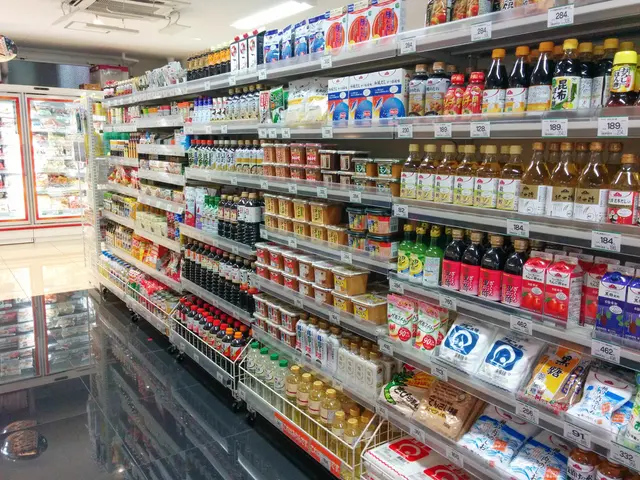Airline emissions across Europe predicted to surpass pre-pandemic amounts
A New Dawn for European Skies, Yet an Uphill Battle for Greener Flying
The skies across Europe are once again filling up with aircraft, on track to surpass pre-pandemic emissions levels this year. This troubling reality underscores the challenges faced by the aviation industry in its quest to reduce carbon footprint, especially given its ongoing lobbying for lenient eco-policies in Brussels.
According to forecasts from Transport & Environment (T&E), CO2 emissions from European airline flights could reach an estimated 195.2 million tonnes this year. This represents a 4% increase over 2019 levels, and more than the 187.6 million tonnes emitted in 2021, a year in which the sector almost completely recovered to pre-pandemic flying levels, as reported by T&E.
European airlines have collectively pledged to achieve net-zero emissions by 2050, taking advantage of new technologies, alternative fuels, carbon trading schemes, and more efficient aircraft, engines, and air traffic management. However, carriers have become vocal about various obstacles that hinder their progress, especially the high cost and insufficient availability of sustainable aviation fuel (SAF).
Last month, the sector urged the EU to moderate some of its environmental regulations, primarily concerning SAF. The CEOs of four major European airlines - including Ryanair and Lufthansa - even suggested that EU rules mandating an annual increase in SAF provision may need to be delayed. They argued that while the initial 2% SAF requirement in 2022 is attainable, a rise to 6% by 2030 would be unachievable given the current levels of SAF production and the low investment in new fuels by oil majors.
The United Kingdom's sustainable fuel regulations demand 10% SAF by 2030, another target that the airlines expressed doubt over achieving. They have also advocated for the EU's and UK's carbon pricing schemes for aviation to be adjusted to align with a less expensive global standard.
The EU responded by emphasizing that the rising number of flights reflects the need for action to meet climate commitments and that "aviation needs to do more." The Commission went on to point out that the aviation sector generates about 4% of the bloc's total greenhouse gas emissions, with a significant increase in travel post-pandemic driving the surge in emissions recorded by T&E.
According to Eurocontrol, the air traffic management body, many European countries already have air traffic levels above 2019 levels, and flights covering the entire continent are expected to exceed those levels in the first half of 2025. Brussels is currently reviewing the scope of its emissions trading scheme (ETS), a primary EU-wide instrument for reducing emissions.
The current ETS only charges airlines for emissions on flights within Europe, with flights outside the region exempted and instead subjected to the international Corsia offsetting scheme. This discrepancy means that the most polluting long-haul flights pay less to emit carbon than shorter flights within Europe. T&E data indicates that the route with the highest emissions in 2024 will be the London to New York route, which was responsible for 1.4 million tonnes of CO2.
If the Corsia scheme fails to strengthen, the Commission may propose extending the scope of the ETS to include flights departing the EU for other destinations. However, analysts anticipate that this move could face fierce opposition from nations such as the US. T&E estimates that expanding the ETS to cover all flights would have cost airlines approximately €7.5 billion last year.
Krisztina Hencz, aviation policy manager at T&E, views the current review of the EU's carbon markets as an opportunity to rectify a loophole and include all airline emissions. "The sector continues to avoid the true cost of its pollution," she said.
The industry group Airlines4Europe counters that the European aviation sector is "leading the way in decarbonizing aviation." They argue that maintaining strict emission regulations may generate headlines but fails to significantly reduce global aviation emissions while potentially compromising Europe's position as a leader in clean aviation.
Insights:
- Dwindling SAF production plans and accompanying high costs could fall 30% short of demand by 2030, posing a significant challenge for the aviation industry.
- The EU's e-SAF mandate faces feedstock shortages, and its infrastructure remains underdeveloped, with none of Europe's 30 large-scale e-SAF projects having reached a final investment decision.
- Competition for available biofuels among various sectors could leave maritime shipping and other industries struggling to find alternatives.
- The industry is lobbying for regulatory leniency regarding SAF requirements, citing challenges in meeting the targets due to production and cost constraints.
- The sector emphasizes the need for strong support for green hydrogen and synthetic fuel infrastructure to avoid potential stranding of assets or fuel shortages.
- Analysts predict that sustainable aviation fuel (SAF) production will fall 30% short of demand by 2030, posing a significant challenge for the aviation industry.
- The EU's e-SAF mandate is faced with feedstock shortages, and its infrastructure remains underdeveloped, with none of Europe's 30 large-scale e-SAF projects having reached a final investment decision.
- Competition for available biofuels among various sectors could leave maritime shipping and other industries struggling to find alternatives.
- European airlines are lobbying for regulatory leniency regarding SAF requirements, citing challenges in meeting the targets due to production and cost constraints.
- The industry is emphasizing the need for strong support for green hydrogen and synthetic fuel infrastructure to avoid potential stranding of assets or fuel shortages.
- In the general news, there is ongoing debate about the investments required to develop and scale up green energy solutions for the transportation industry, particularly airlines.
- The financial industry is closely watching the policy-and-legislation surrounding climate-change, emissions, and environmental-science, as they could significantly impact the business models of airlines and energy companies.
- As the industry moves towards the 2025 target for emissions reductions, the business environment will become increasingly complex, driven by science, politics, and market dynamics.
- While some analysts believe that airlines for Europe are genuine in their commitment to reducing emissions and achieving net-zero by 2050, others question whether the industry is doing enough to address climate-change, considering the anticipated growth in air travel over the coming years.







